Abstract
A method was devised to test the growth-promoting ability of a broth medium. The "dilute to extinction" method determines the inoculum required to develop heavy turbidity in a broth with overnight incubation. A statistical method using Poisson distribution was used to show that a single Haemophilus cell can develop heavy turbidity in an optimal broth. The dilute to extinction method was used to evaluate the shelf life of stored media, to titrate the growth factor requirements of Haemophilus, and to evaluate the use of purified hemin and nicotinamide adenine dinucleotide in a broth medium for the growth of Haemophilus. Of the media tested, the most suitable formulation was Mueller-Hinton broth supplemented with 10 microgram of hemin and 10 microgram of nicotinamide adenine dinucleotide per ml. The dilute to extinction method appears to be especially useful in the development of broth media for fastidious organisms. The method could also be used to assure the quality of other broth media which are required to support the growth of small inocula in the clinical or research laboratory.
Full text
PDF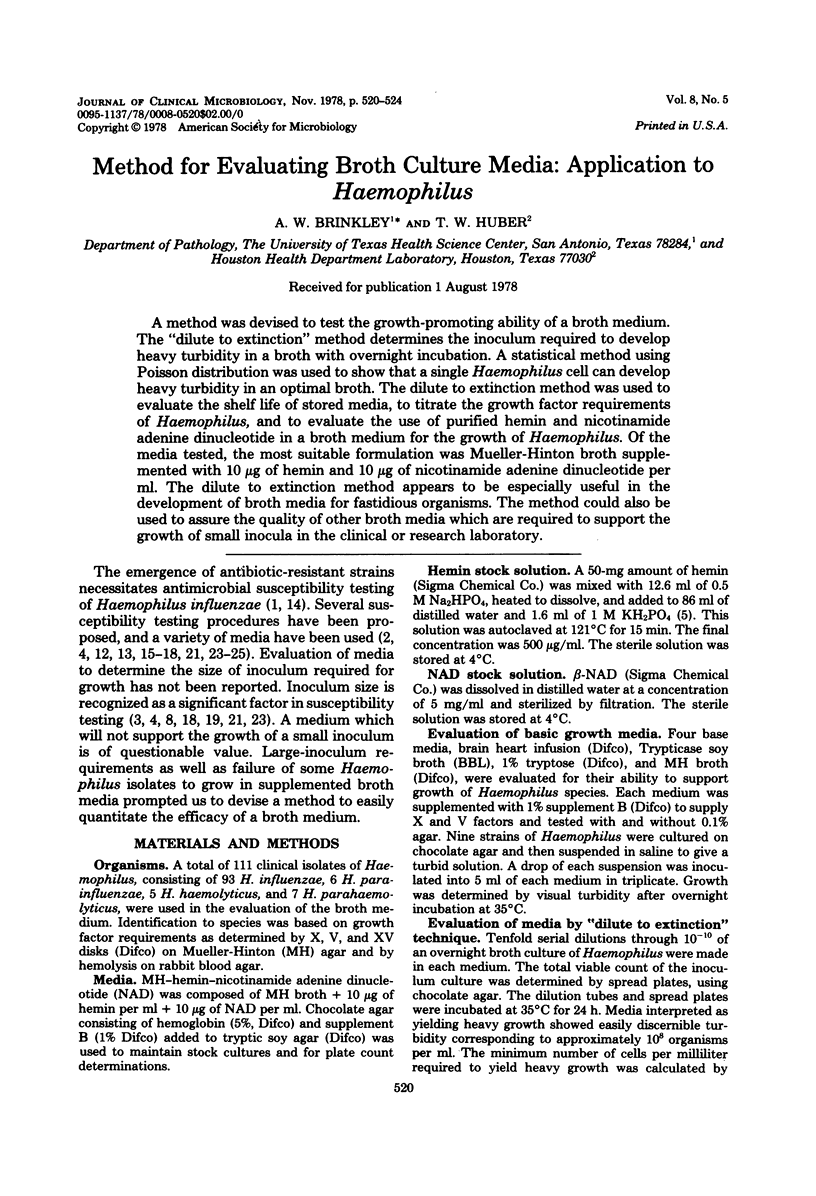
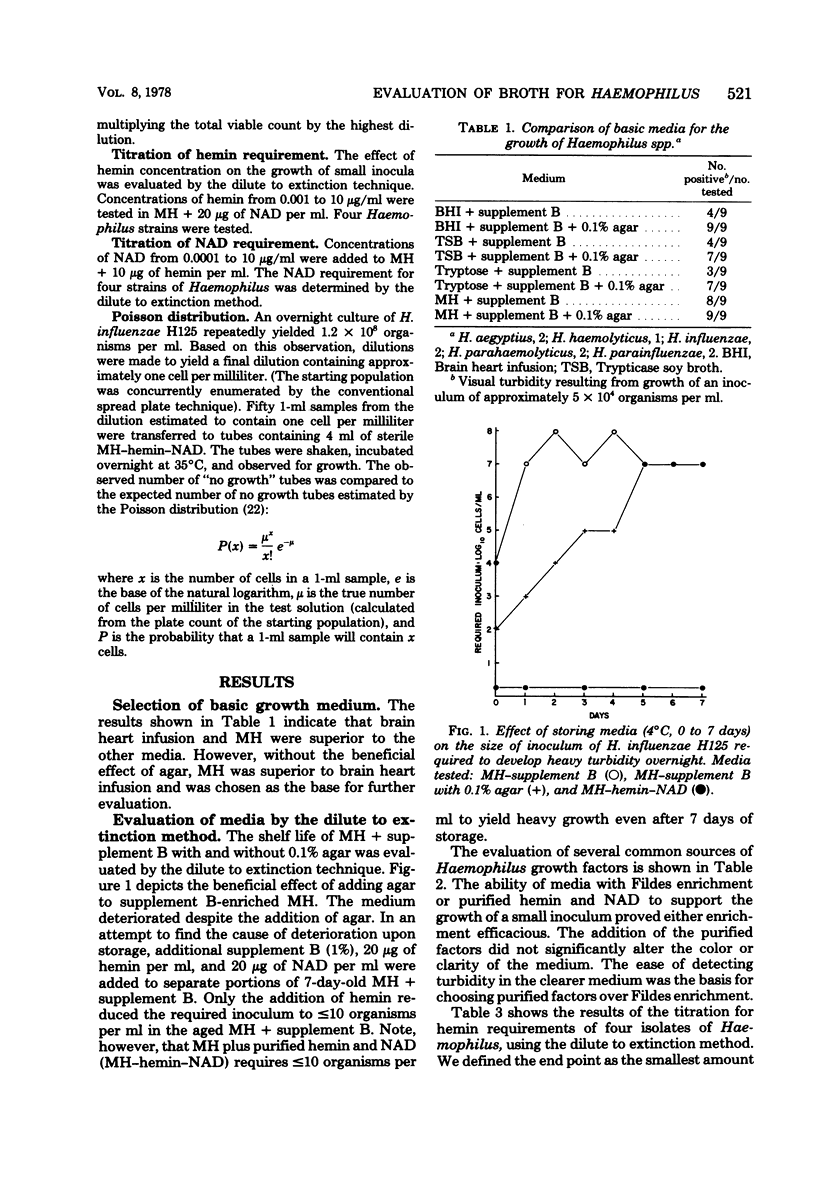
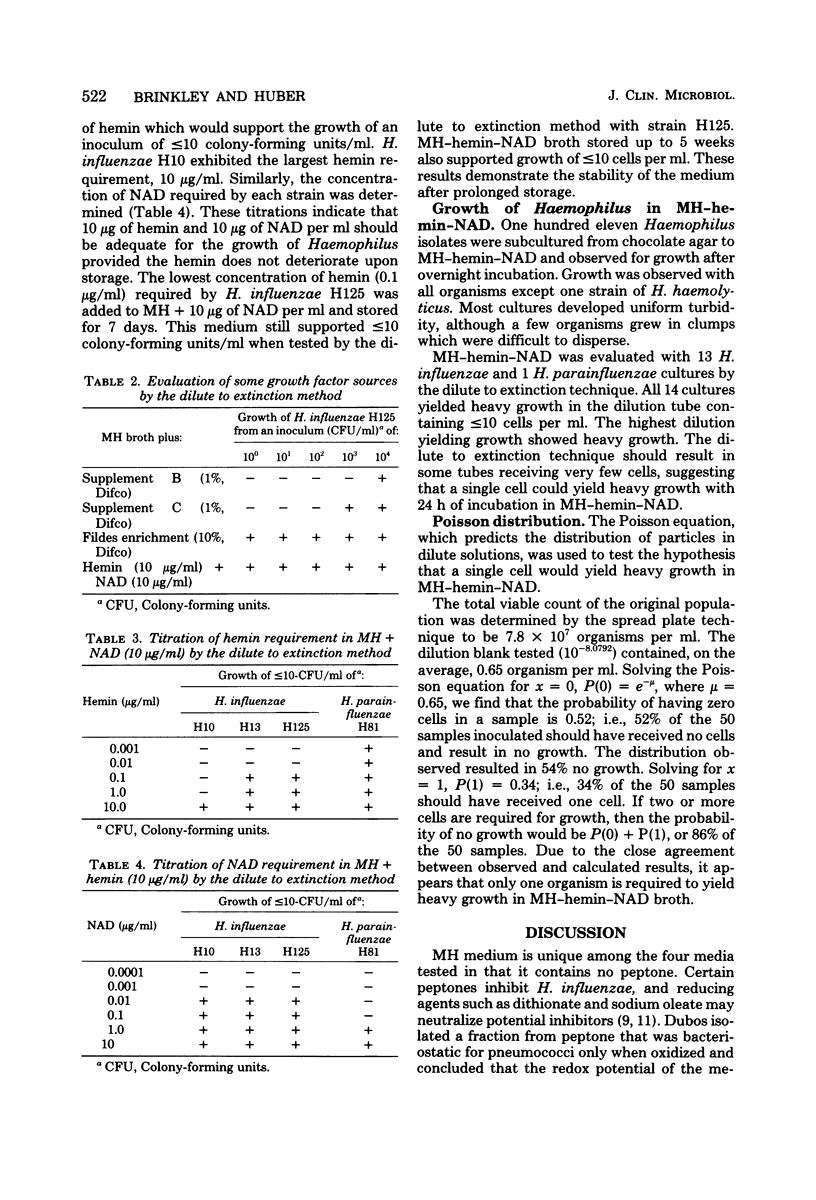
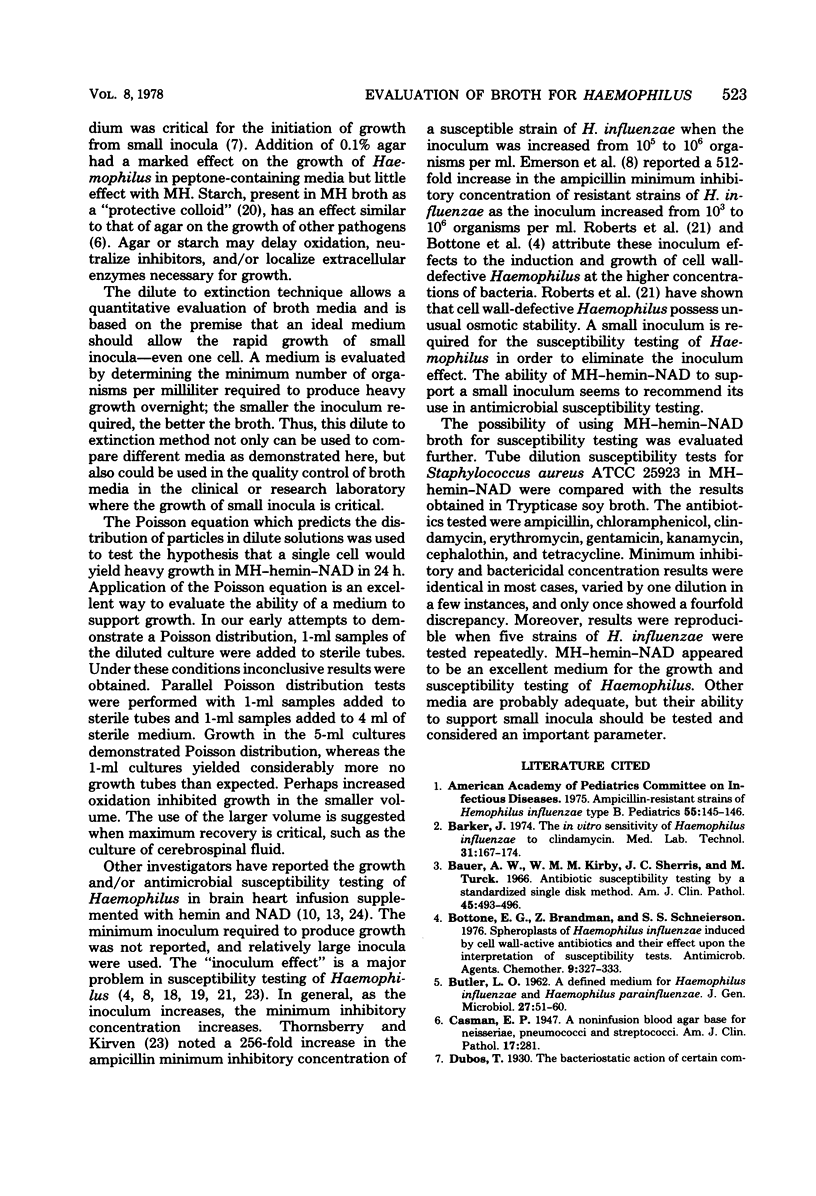
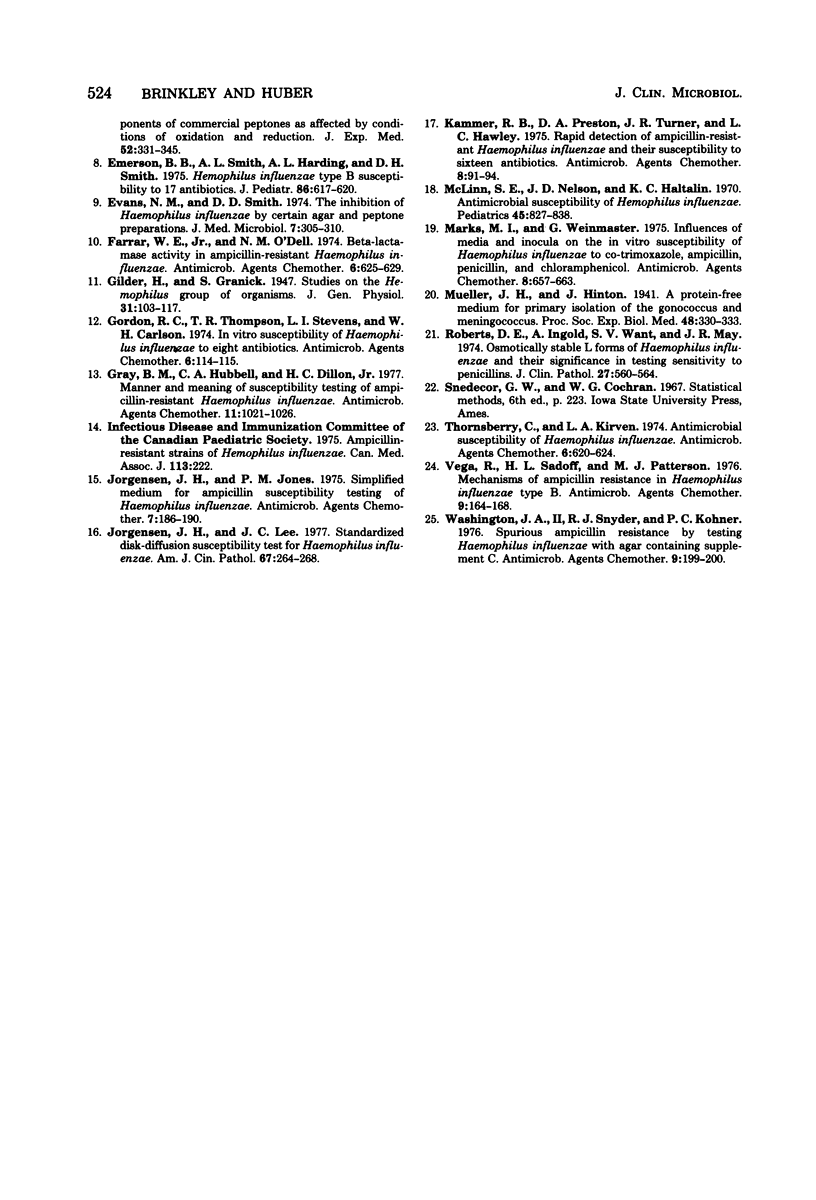
Selected References
These references are in PubMed. This may not be the complete list of references from this article.
- BUTLER L. O. A defined medium for Haemophilus influenzae and Haemophilus parainfluenzae. J Gen Microbiol. 1962 Jan;27:51–60. doi: 10.1099/00221287-27-1-51. [DOI] [PubMed] [Google Scholar]
- Barker J. The in vitro sensitivity of Haemophilus influenzae to clindamycin. Med Lab Technol. 1974 Apr;31(2):167–174. [PubMed] [Google Scholar]
- Bauer A. W., Kirby W. M., Sherris J. C., Turck M. Antibiotic susceptibility testing by a standardized single disk method. Am J Clin Pathol. 1966 Apr;45(4):493–496. [PubMed] [Google Scholar]
- Bottone E. J., Brandman Z., Schneierson S. S. Spheroplasts of Haemophilus influenzae induced by cell wall-active antibiotics and their effect upon the interpretation of susceptibility tests. Antimicrob Agents Chemother. 1976 Feb;9(2):327–333. doi: 10.1128/aac.9.2.327. [DOI] [PMC free article] [PubMed] [Google Scholar]
- Emerson B. B., Smith A. L., Harding A. L., Smith D. H. Hemophilus influenzae type B susceptibility to 17 antibiotics. J Pediatr. 1975 Apr;86(4):617–620. doi: 10.1016/s0022-3476(75)80166-1. [DOI] [PubMed] [Google Scholar]
- Evans N. M., Smith D. D. The inhibition of Haemophilus influenzae by certain agar and peptone preparations. J Med Microbiol. 1974 May;7(2):305–310. doi: 10.1099/00222615-7-2-305. [DOI] [PubMed] [Google Scholar]
- Farrar W. E., Jr, O'Dell N. M. Beta-lactamase activity in ampicillin-resistant Haemophilus influenzae. Antimicrob Agents Chemother. 1974 Nov;6(5):625–629. doi: 10.1128/aac.6.5.625. [DOI] [PMC free article] [PubMed] [Google Scholar]
- Gordon R. C., Thompson T. R., Stevens L. I., Carlson W. H. In vitro susceptibility of Haemophilus influenzae to eight antibiotics. Antimicrob Agents Chemother. 1974 Jul;6(1):114–115. doi: 10.1128/aac.6.1.114. [DOI] [PMC free article] [PubMed] [Google Scholar]
- Gray B. M., Hubbell C. A., Dillon H. C., Jr Manner and meaning of susceptibility testing of ampicillin-resistant Haemophilus influenzae. Antimicrob Agents Chemother. 1977 Jun;11(6):1021–1026. doi: 10.1128/aac.11.6.1021. [DOI] [PMC free article] [PubMed] [Google Scholar]
- Jorgensen J. H., Jones P. M. Simplified medium for ampicillin susceptibility testing of Haemophilus influenzae. Antimicrob Agents Chemother. 1975 Feb;7(2):186–190. doi: 10.1128/aac.7.2.186. [DOI] [PMC free article] [PubMed] [Google Scholar]
- Jorgensen J. H., Lee J. C. Standardized disk-diffusion susceptibility test for Haemophilus influenzae. Am J Clin Pathol. 1977 Mar;67(3):264–268. doi: 10.1093/ajcp/67.3.264. [DOI] [PubMed] [Google Scholar]
- Kammer R. B., Preston D. A., Turner J. R., Hawley L. C. Rapid detection of ampicillin-resistant Haemophilus influenzae and their susceptibility to sixteen antibiotics. Antimicrob Agents Chemother. 1975 Jul;8(1):91–94. doi: 10.1128/aac.8.1.91. [DOI] [PMC free article] [PubMed] [Google Scholar]
- Marks M. I., Weinmaster G. Influences of media and inocula on the in vitro susceptibility of Haemophilus influenzae to co-trimoxazole, ampicillin, penicillin, and chloramphenicol. Antimicrob Agents Chemother. 1975 Dec;8(6):657–663. doi: 10.1128/aac.8.6.657. [DOI] [PMC free article] [PubMed] [Google Scholar]
- May J. R., Roberts D. E., Ingold A., Want S. V. Osmotically stable L forms of Haemophilus influenzae and their significance in testing sensitivity to penicillins. J Clin Pathol. 1974 Jul;27(7):560–564. doi: 10.1136/jcp.27.7.560. [DOI] [PMC free article] [PubMed] [Google Scholar]
- McLinn S. E., Nelson J. D., Haltalin K. C. Antimicrobial susceptibility of Hemophilus influenzae. Pediatrics. 1970 May;45(5):827–838. [PubMed] [Google Scholar]
- Thornsberry C., Kirven L. A. Antimicrobial susceptibility of Haemophilus influenzae. Antimicrob Agents Chemother. 1974 Nov;6(5):620–624. doi: 10.1128/aac.6.5.620. [DOI] [PMC free article] [PubMed] [Google Scholar]
- Vega R., Sadoff H. L., Patterson M. J. Mechanisms of ampicillin resistance in Haemophilus influenzae type B. Antimicrob Agents Chemother. 1976 Jan;9(1):164–168. doi: 10.1128/aac.9.1.164. [DOI] [PMC free article] [PubMed] [Google Scholar]
- Washington J. A., 2nd, Snyder R. J., Kohner P. C. Spurious ampicillin resistance by testing Haemophilus influenzae with agar containing supplement C. Antimicrob Agents Chemother. 1976 Jan;9(1):199–200. doi: 10.1128/aac.9.1.199. [DOI] [PMC free article] [PubMed] [Google Scholar]


